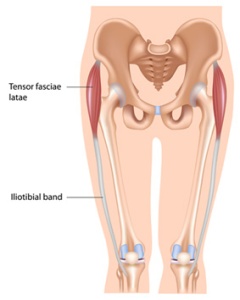The most common cause of lateral knee pain is ITBS (Iliotibial Band Syndrome).
 The Iliotibial Band (ITB) is a thick band of tissue on the outside of the thigh. The ITB begins at the upper hip extending down the outside of the thigh connecting with the tibia (shin bone) at just below the knee. It is crucial in stabilizing the knee during excess activities and is common in runners and cyclists in the age group of 15-50.
The Iliotibial Band (ITB) is a thick band of tissue on the outside of the thigh. The ITB begins at the upper hip extending down the outside of the thigh connecting with the tibia (shin bone) at just below the knee. It is crucial in stabilizing the knee during excess activities and is common in runners and cyclists in the age group of 15-50.
The ITB is aggravated and irritated through excess repeated motion causing pain and inflammation. Bony anatomical prominences located on the outside of the thigh rub against this band causing friction. Often a clicking sound can result from the tight band moving over the surfaces. ITBS is aggravated during activities such as running up hills or on slanted surfaces.
Pain is typically described as on the outside of the knee or hip, exacerbated by motion and relieved during rest. ITBS can be relatively easy to treat following correct examination, such as with stretching, strengthening, reduced strenuous activity and ice.
Five top ways to promote quicker healing (including services at Champneys)
By creating an optimal psychological, nutritional and physiological environment, the body is able to focus purely on the job in hand – healing the particular injury/ailment.
The services provided through the Regenerate programme at Champneys Tring in Hertfordshire can help to create this ideal environment in the following ways:
 Decrease emotional stress and distractions and ensure you are having the correct amount of rest and sleep
Decrease emotional stress and distractions and ensure you are having the correct amount of rest and sleep- Decrease environmental stress
- Ensure best and optimal circulation (acupuncture, kriotherapy)
- Optimal and appropriate nutrition (nutritionist)
- Exercising within the pain-free range and at an appropriate level for maximising healing potential (hydrotherapy, physiotherapy)
Regenerate is the UK’s leading residential medical centre based within the world class Champneys Tring Health Resort in Hertfordshire. Offering a bespoke professional service for injury rehabilitation, Regenerate provides the ultimate medical expertise and treatments required to recover physically, mentally and emotionally from all aspects of injury. Clients also benefit from using Champneys many services, as well as their luxury spa facilities and treatments.
Regenerate provides the highest standards and employs leading professionals in the medical fields under the Directorate of Champneys Medical Director, Dr Michael Curtin MB ChB Dip Med Ac. MF HOM. Regenerates multidisciplinary team includes: Doctor, Acupuncturists, Physiotherapists, Exercise Physiologists, Movement Therapists, Nutritionists, Personal Trainers, and Motivational and Mental Skills Coaches. They will conduct comprehensive examinations and diagnostic testing, and provide appropriate treatment which may include physiotherapy, acupuncture, clinical pilates, kriotherapy, nutritional therapy, exercise and rehabilitation programmes, sports massage, vibrogym therapy and altitude training, amongst others.
More Information
Blog Post by Emma James March 2016




Recent Comments